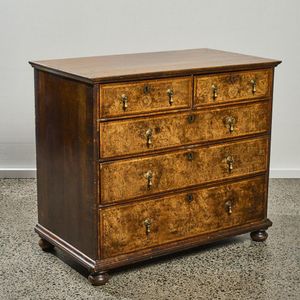18th Century Walnut Commode with Inlays and Burr Fronts
A William and Mary walnut commode, an 18th century English walnut chest of drawers. With quartered, feathered, and cross-banded top. Featuring herringbone inlays and figured burr drawer fronts with cast drop handles. Sitting on raised bun feet. Height 90 cm, width 102 cm, depth 55.5 cm
You must be a subscriber, and be logged in to view price and dealer details.
Subscribe Now to view actual auction price for this item
When you subscribe, you have the option of setting the currency in which to display prices to $Au, $US, $NZ or Stg.
This item has been sold, and the description, image and price are for reference purposes only.
- Figured - A descriptive term to describe the patterns in the grain of timber. An object may be described as "well figured" or "highly figured" if the grain on a section of the object is highly patterned, as with flame mahogany or burr walnut.
- Commode - The word "commode" when used to describe an item of furniture, has three usuages:
1. As used to describe an item of English furniture, it refers to what is euphemistically called a 'night table', that is a small cabinet concealing a chamber pot.
2. In its 18th century French usuage it describes a low and highly decorated chest of drawers for salons and reception rooms. A bombe commode is a commode with rounded sides and front, giving the chest a somewhat swollen look.
3. It is also used to denote a half round or serpentine shaped cabinet, with panelled doors, standing on legs. They were pieces on which the cabinetmaker lavished his most accomplished art, with rich veneers, marquetry inlays, gilt mounts and other ornamentation. - Crossbanding - Crossbanding is a decorative technique used in furniture-making, where thin strips of wood, known as crossbands, are applied to the surface of a piece of furniture to create a decorative border or inlay. The crossbands are typically made of a different type of wood or a different color than the main piece of furniture, and are applied in a geometric pattern, such as a checkerboard or herringbone design.
Crossbanding was a popular decorative technique in furniture-making from the 17th to the 19th centuries, particularly in the Baroque, Rococo, and Chippendale styles. It was often used to create intricate patterns and designs on the surfaces of tables, desks, cabinets, and other pieces of furniture. The crossbands were often made of exotic woods, such as ebony or rosewood, which were imported from other parts of the world and were highly prized for their rich colors and patterns. - Drop Handles - In furniture of the late 17th and early 18th centuries, small metal drop handles were often used, frequently in a pear or tear shape. The back plate, to which the drop was attached, may be either a simple plain circle, or in the form of a star or diamond. These handles have been widely reproduced, and are frequently found on Jacobean and Queen Anne style furniture made after the first world war. Reproduction handles can usually be identified by the inferior quality of the metal used during the 1920s and 1930s, sometimes thinly coated with brass or copper, though modern copies are often of excellent quality.
- Burr - Burr (or in the USA, burl) is the timber from the knotted roots or deformed branch of the tree, which when cut, displays the small circular knots in various gradations of colour. It is always cut into a decorative veneer, most commonly seen as burr walnut on 19th century furniture.
- Herringbone Pattern in Furniture - The herringbone pattern is a popular decorative pattern used in furniture, created by inlaying small rectangular pieces of veneer in a zig-zag pattern, similar to the pattern found in the herringbone link used in jewellery. The pieces of veneer are cut at a 45-degree angle to create the distinctive V-shape, and are arranged in a way that creates a seamless, interlocking pattern.
The herringbone pattern in veneer can be used in a variety of ways in furniture design. It is commonly used on table tops, cabinet doors, and other flat surfaces, where it can add visual interest and texture to the piece. It can also be used on curved surfaces, such as the front of a chest of drawers or the top of a curved console table, where it can create a dramatic and eye-catching effect. - Bun Feet - Similar to ball feet, though somewhat compressed or flattened in appearance. Introduced during the late 17th century, but they have been used on furniture up to the present day.
This item has been included into following indexes:
- chests of drawers, material - walnut 480
-
chests of drawers, period
- Georgian 777
- William & Mary 34
